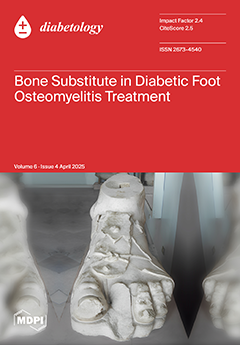Background: Microvascular disease (MVD) describes systemic changes in small vessels (~100 µm diameter or smaller) that impair tissue oxygenation and perfusion. MVD has been demonstrated to play an independent role in the risk of limb loss. Despite this relevance, MVD is not
[...] Read more.
Background: Microvascular disease (MVD) describes systemic changes in small vessels (~100 µm diameter or smaller) that impair tissue oxygenation and perfusion. MVD has been demonstrated to play an independent role in the risk of limb loss. Despite this relevance, MVD is not regularly assessed clinically because tools used to evaluate and quantify the severity of MVD of the foot remain limited. We sought to evaluate if the Semmes-Weinstein 10-g Monofilament (SWM) can be used to stratify clinical MVD severity.
Methods: We evaluated a racially diverse cohort of 124 patients (with 248 limbs). SWM testing was performed on the plantar aspect of the feet at 1st, 3rd
, and 5th metatarsophalangeal joints. Clinical MVD was stratified in an ascending order of severity into: no diabetes; type 2 diabetes (DM); diabetes+ neuropathy (DM+N); diabetes + neuropathy + retinopathy (DM+N+R). Logistic regression models were used to examine the association between a patient’s clinical MVD severity and an abnormal SWM test.
Results: Sixty-four patients (51.6%) tested had an abnormal sensation. The odds of an abnormal SWM test were significantly higher for patients with DM+N and DM+N+R compared to those with no DM respectively. (DM vs. No DM: OR: 3.58, [0.98–13.09],
p = 0.05; DM+N vs. No DM: OR: 30.46, [10.33–105.17],
p < 0.001; DM+N+R vs. No DM: OR: 43.00, [9.89–309.17],
p < 0.001). Furthermore, we categorized SWM based on the degree of sensation loss and found that the proportion of people with a higher degree of sensation loss increased across the clinical MVD severity spectrum.
Conclusions: Abnormal SWM sensation strongly correlates with the severity of clinical MVD. This suggests that a simple, non-invasive, 1-min SWM test that can be done in the clinic is a promising tool in assessing MVD in the feet, which is particularly significant considering MVD involvement in limb loss.
Full article





